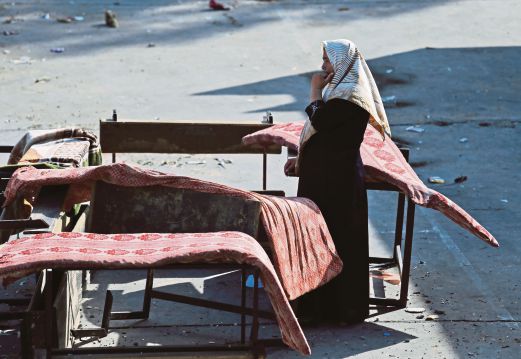The Gaza crisis: In search of humanity
Professor Tan Sri Dato' Dzulkifli Abdul Razak
Learning Curve: Perspective
New Sunday Times - 03-8-2014
AS Muslims around the world were preparing for the auspicious Eid-ul Fitr on July 28, after observing a month-long fast, the festivity was marred by the Day of Rage.
Palestinians, numbering at least 10,000 in the West Bank, staged a protest as the death toll of innocent civilians continued to rise. It came just after the shelling of a school under the control of the United Nations Relief and Works Agency (UNRWA) that became a makeshift shelter for displaced Gazans desperately looking for a haven. At least 15 lives — mostly children —- were lost, bringing the number of casualties to more than 1,000 to date. If the earlier deaths failed to draw attention, the bombing of the UN school at Beit Hanoun raised concern. Washington was reportedly “deeply saddened” by the tragedy whereas five days before the ground invasion of Gaza, a communique following the meeting between US President Barack Obama and British Prime Minister David Cameron omitted any mention of Gaza. The more than 150 lives already wasted then were somehow not important enough.
The tragic incident at the school raised a series of international condemnations as it was “the first time Palestinian refugees have died inside UN facilities” since the onslaught. UN secretary-general Ban Ki-Moon was “appalled”. Under-Secretary-General for humanitarian affairs Baroness Valerie Amos highlighted the “terrible, terrible situation” where “so many children have been killed as a result of the violence in the last few days”. Allegedly, one child was killed every hour over the past three days before the school bombing. This is in spite of UNRWA spokesperson Chris Gunness’ revelation that the “precise coordinates of the UNRWA shelter” were formally made known. In fact, the UNRWA attempt to coordinate “a window for civilians to leave” was unsuccessful.

A displaced Palestinian waits with the mattresses she got for members of her family at the Abu Hussein UN school, in Jebaliya refugee camp, northern Gaza Strip
The Office for the Coordination of Humanitarian Affairs (OCHA) said that six UN-run schools have already been damaged. They are among 83 "makeshift shelters" hosting at least 140,000 people who have been forced to evacuate their homes. OCHA said "there is literally no safe place for civilians" in Gaza since it is hemmed in on all sides by years of illegal blockade despite assurances that it will be lifted some years ago. Of late, a Greek Orthodox church in Zaytun has opened its doors to provide shelter.
On the early morning shelling of another UN-run school at Jabalia a few days later, the UNRWA Commissioner-General Pierre Krähenbühl said: “Children killed in their sleep; this is an affront to all of us, a source of universal shame. Today the world stands disgraced.” In reality, “about 44 per cent of Gaza” is not accessible to those leaving their homes, making them more vulnerable.
Omar Mansour, an ambulance driver and paramedic, said: “The smell of blood is everywhere.” This statement resonates with Amos’ description of the situation in Gaza as a dire humanitarian crisis where “the majority of those killed are women, children and men who have nothing to do with the fighting”. The massacre of the innocents becomes more inhuman by the day, predicated on the outmoded dictum: might is right. Even so-called more civilised nations subscribe to this regardless of going against world opinion or if such a stance costs inhuman impact to innocent bystanders.
It is for this reason that the Kuala Lumpur Initiative to Criminalise War — launched almost 10 years ago in December 2005 with a consensus declaration statement on the need to end all wars of aggression as a means of ensuring the survival of humanity — is particularly relevant.
Succinctly, it maintains: “Killings in war are as criminal as the killings within societies in times of peace. Since killings in peace time are subject to the domestic law of crime, killings in war must likewise be subject to the international law of crimes. This should be so irrespective of whether these killings in war are authorised or permitted by domestic law.”
The KL Declaration also calls for the criminalisation of the military-industrial complex including the so-called defence contractors as well as science labs which conceptualise and develop advanced weapons systems: “All commercial, financial, industrial and scientific activities that aid and abet war should be criminalised”, encompassing corporate media as well.
On the contrary, educational institutions as the custodian of human civilisation must play a more catalytic role to broker and build peace as part of the mission. More than ever they are called to nurture peace mindsets by rigorously implementing one of Unesco’s pillars of learning, namely learning to live together, beyond the other three: learning to do, learning to know and learning to be. Schools and similar learning-related institutions therefore are fundamental to this process, and must stand as beacons of peace for humanity rather than be part of the military-industrial complex.
